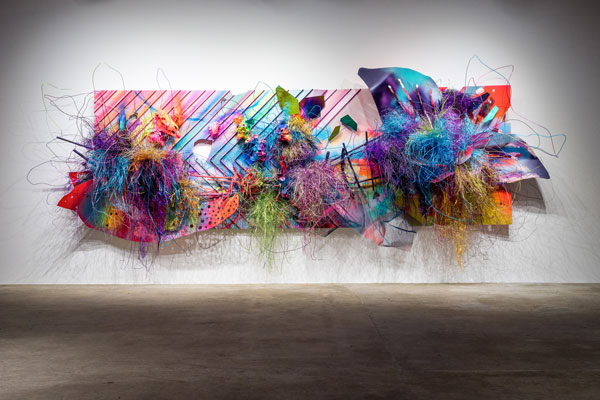Arne Quinze’s jubilantly comely show, “Jungle Cities,” propounds fundamental questions about the problematic relationship between culture and nature. These questions align with the artist’s generally stated ambitions; however, the most urgent of them are posed incidentally, occurring by way of malapropos form and infelicitous use of materials.
As its title suggests, the exhibition encompasses qualities both metropolitan and vegetal. Overtaking white walls and spilling across concrete floor, the installation dazzles like an artificial rainforest exploding with psychedelic cutouts and tangled vines whose metallic factitiousness screams urban flashiness.
Before descending a ramp into the inviting exhibition space, viewers pass a wall bearing a statement, apparently handwritten by the artist, about humans’ detrimental ecological impact. Quinze reprehends the mass devastation of flora and fauna by mankind, avows it his artistic duty to call attention to the balance between culture and nature, and declares his sculptures “inspired by the endless diversity and beauty of nature.”
However, these artworks bear few indications of nature. On the contrary, they do little more than ingratiate humans’ artificial saccharine tastes. Beautiful they are, in surfeit. Diverse they are not. Wire ravels and metal sheets arranged in Elizabeth Murray-esque constructions and Lisa Frank palette appear in each piece and hallmark Quinze’s fabricated aesthetic.
His brilliant colors would be fantastic in a jungle; his forms are more fabulously abstract than Dale Chihuly’s glass flowers. A few lucid passages do seem organismic. A green tangle dangling from Superba (all works 2016) appears as flowing grass. In Saint Helena, unnaturally hued plants and tree stump act as focal point, anchoring a snarled wire mass. This smallest sculpture is by far the most effective, convincingly highlighting nature and its equipoise, or lack thereof, with human constructs.
Other pieces skew so far towards artificiality that natural indications barely play a role amid gaudy wires and planes. In fact, were it not for Quinze’s statement, one would hardly heed the animal skulls and plants easily dismissed as decorative formalist accessories spray-painted to match their surrounding razzle-dazzle. Even when noted, they are quickly forgotten, overshadowed by the arrant seductiveness of gorgeous baubles and candy tincture. All pretty felicity with no dark side, these farces of nature don’t unmask people’s ecological ignorance; they cater to it.

Arne Quinze, Superba, 2016, ©Arne Quinze, courtesy of DENK Gallery
Saint Helena and Lepidodendron are the only pieces containing nuanced detail rewarding viewing from a wide range of angles and distances. Perhaps this results from Quinze’s large-scale public art background falling flat in a gallery setting. The artist has expressed ambition to beautify banal cityscapes, and at this his work succeeds; but mere beautification is insufficient for accomplishing his stated environmental goals.
To that end, planting trees or creating sculptures from recycled materials would be more effective than mounting pristine, grandiose permanent sculptures that destroy flora and fauna and their habitats. Casting metals produces environmentally hazardous emissions. To counterbalance their own ecological footprints, his artworks would need to broadcast a message of environmental concern.
One reason for mankind’s wanton destructiveness is its insistence upon enforcing artificial definitions of beauty at the expense of other organisms. Though a joy to behold, Quinze’s art perpetuates the very paradigms that he speaks of counteracting.


